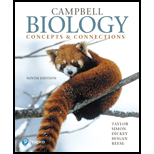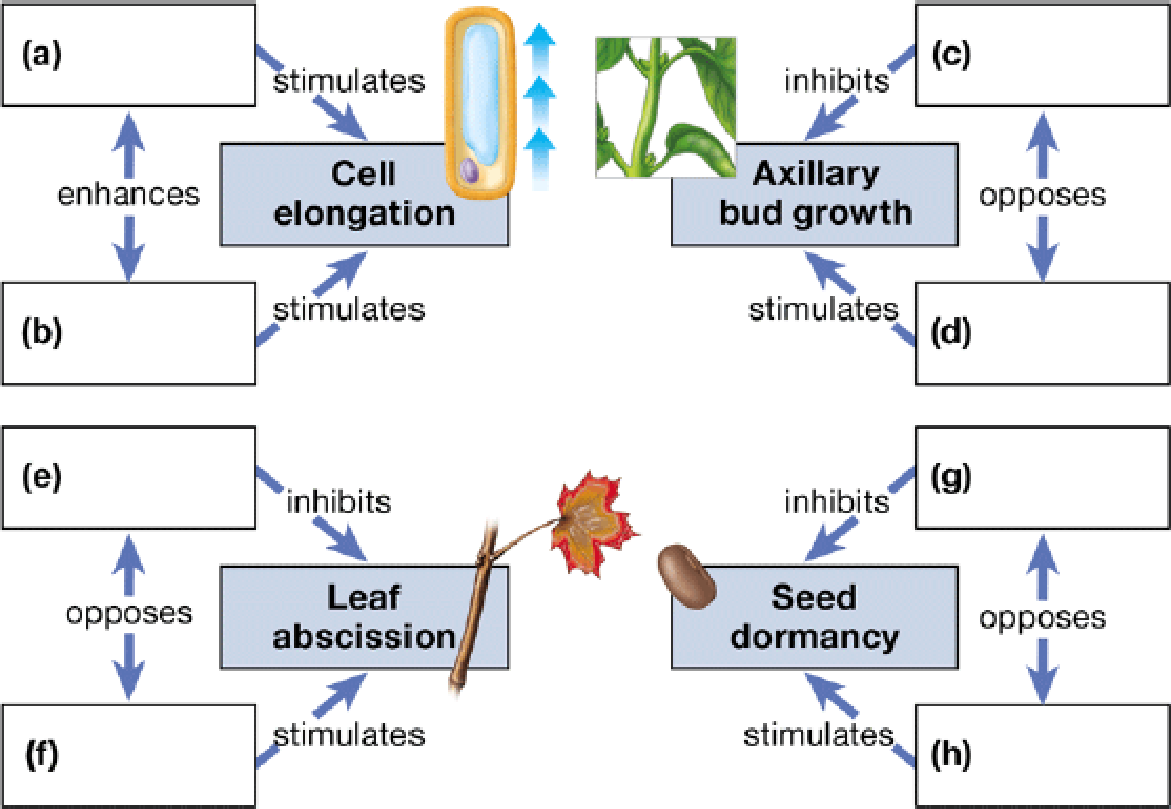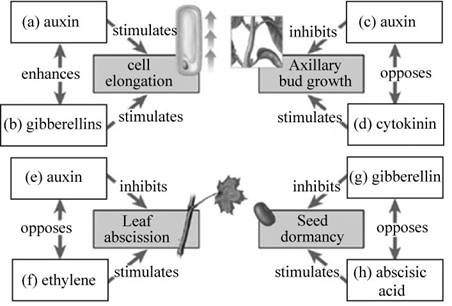
Test your knowledge of the five major classes of plant hormones (auxins, cytokinins, gibberellins, abscisic acid, ethylene) by matching one hormone to each lettered box. (Note that some hormones will match up to more than one box.)

To complete: The given map of the five major classes of plant hormones.
Concept introduction:
Plant hormones are chemical messengers that are produced in trace amounts, but profoundly affect the growth and development of a plant. These include auxins, cytokinins, gibberellins, abscisic acid and ethylene.
The plant hormones perform various functions such as promoting growth, breaking dormancy, mediating fruit ripening and providing tolerance to stress.
Explanation of Solution
Pictorial representation: Fig.1 shows the completed map representing the five major classes of plant hormones.

Fig.1: The five major classes of plant hormones.
(a)
Correct answer: Auxin.
Explanation: Auxins are a group of plant hormones that promotes cell elongation. They are produced by the apical meristems of shoot and root. They promote the growth of root and shoot of the plant. Hence the correct answer is auxin.
(b)
Correct answer: Gibberellins.
Explanation: The gibberellins are a group of plant hormones that stimulate the elongation of stem by promoting cell elongation. Hence the correct answer is gibberellins.
(c)
Correct answer: Auxin.
Explanation: Auxin is produced by the apical bud of the shoot and functions to inhibit the growth of axillary buds, a phenomenon called apical dominance. Hence, the correct answer is auxin.
(d)
Correct answer: cytokinin.
Explanation: The cytokinins are a group of plant hormones that stimulate rapid cell division in roots and shoots of the plant. It also promotes the growth of lateral buds, thereby nullifying the effects of auxin. Hence, the correct answer is cytokinin.
(e)
Correct answer: Auxin.
Explanation: In addition to cell elongation, the auxins also function to retard the abscission of leaves. It also plays a crucial role in nullifying the effects of ethylene. Hence, the correct answer is auxin.
(f)
Correct answer: Ethylene.
Explanation: Ethylene is a gaseous hormone that promotes ripening of fruit and abscission of leaves from trees. Hence, the correct answer is ethylene.
(g)
Correct answer: Gibberellin.
Explanation: The gibberellin is a plant hormone that promotes the germination of seed. It inhibits seed dormancy by nullifying the effects of abscisic acid. Hence the correct answer is gibberellin.
(h)
Correct answer: Abscisic acid.
Explanation: The abscisic acid is a plant hormone that is involved in the stress responses. It inhibits growth, promotes seed dormancy during winter or periods of drought. Hence, the correct answer is abscisic acid.
Want to see more full solutions like this?
Chapter 33 Solutions
Campbell Biology: Concepts & Connections (9th Edition)
- View History Bookmarks Window Help Quarter cements ents ons (17) YouTube Which amino acids would you expect to find marked on the alpha helix? canvas.ucsc.edu ucsc Complaint and Grievance Process - Academic Personnel pach orations | | | | | | | | | | | | | | | | 000000 000000000 | | | | | | | | | | | | | | | | | | | | | | 00000000 scope vious De 48 12.415 KATPM FEB 3 F1 F2 80 F3 a F4 F5 2 # 3 $ 85 % tv N A の Mon Feb 3 10:24 PM Lipid bilayer Submit Assignment Next > ZOOM < Å DII 8 བ བ F6 16 F7 F8 F9 F10 34 F11 F12 & * ( 6 7 8 9 0 + 11 WERTY U { 0 } P deletearrow_forwardDifferent species or organisms research for ecologyarrow_forwardWhat is the result of the following gram stain: positive ○ capsulated ○ acid-fast ○ negativearrow_forward
- What type of stain is the image below: capsule stain endospore stain gram stain negative stain ASM MicrobeLibrary.org Keplingerarrow_forwardWhat is the result of the acid-fast stain below: Stock Images by Getty Images by Getty Images by Getty Images by Getty Image Getty Images St Soy Getty Images by Getty Images by Getty Images Joy Getty encapsulated O endosporulating negative ○ positivearrow_forwardYou have a stock vial of diligence 75mg in 3ml and need to draw up a dose of 50mg for your patient.how many mls should you draw up to give this dosearrow_forward
- You are recquired to administer 150mg hydrocortisone intravenously,how many mls should you give?(stock =hydrocortisone 100mg in 2mls)arrow_forwardIf someone was working with a 50 MBq F-18 source, what would be the internal and external dose consequences?arrow_forwardWe will be starting a group project next week where you and your group will research and ultimately present on a current research article related to the biology of a pathogen that infects humans. The article could be about the pathogen itself, the disease process related to the pathogen, the immune response to the pathogen, vaccines or treatments that affect the pathogen, or other biology-related study about the pathogen. I recommend that you choose a pathogen that is currently interesting to researchers, so that you will be able to find plenty of articles about it. Avoid choosing a historical disease that no longer circulates. List 3 possible pathogens or diseases that you might want to do for your group project.arrow_forward
- not use ai pleasearrow_forwardDNK dagi nukleotidlar va undan sintezlangan oqsildagi peptid boglar farqi 901 taga teng bo'lib undagi A jami H boglardan 6,5 marta kam bo'lsa DNK dagi jami H bog‘lar sonini topingarrow_forwardOne of the ways for a cell to generate ATP is through the oxidative phosphorylation. In oxidative phosphorylation 3 ATP are produced from every one NADH molecule. In respiration, every glucose molecule produces 10 NADH molecules. If a cell is growing on 5 glucose molecules, how much ATP can be produced using oxidative phosphorylation/aerobic respiration?arrow_forward
 Biology (MindTap Course List)BiologyISBN:9781337392938Author:Eldra Solomon, Charles Martin, Diana W. Martin, Linda R. BergPublisher:Cengage Learning
Biology (MindTap Course List)BiologyISBN:9781337392938Author:Eldra Solomon, Charles Martin, Diana W. Martin, Linda R. BergPublisher:Cengage Learning Biology: The Dynamic Science (MindTap Course List)BiologyISBN:9781305389892Author:Peter J. Russell, Paul E. Hertz, Beverly McMillanPublisher:Cengage Learning
Biology: The Dynamic Science (MindTap Course List)BiologyISBN:9781305389892Author:Peter J. Russell, Paul E. Hertz, Beverly McMillanPublisher:Cengage Learning
 Biology: The Unity and Diversity of Life (MindTap...BiologyISBN:9781337408332Author:Cecie Starr, Ralph Taggart, Christine Evers, Lisa StarrPublisher:Cengage Learning
Biology: The Unity and Diversity of Life (MindTap...BiologyISBN:9781337408332Author:Cecie Starr, Ralph Taggart, Christine Evers, Lisa StarrPublisher:Cengage Learning Biology 2eBiologyISBN:9781947172517Author:Matthew Douglas, Jung Choi, Mary Ann ClarkPublisher:OpenStax
Biology 2eBiologyISBN:9781947172517Author:Matthew Douglas, Jung Choi, Mary Ann ClarkPublisher:OpenStax Biology: The Unity and Diversity of Life (MindTap...BiologyISBN:9781305073951Author:Cecie Starr, Ralph Taggart, Christine Evers, Lisa StarrPublisher:Cengage Learning
Biology: The Unity and Diversity of Life (MindTap...BiologyISBN:9781305073951Author:Cecie Starr, Ralph Taggart, Christine Evers, Lisa StarrPublisher:Cengage Learning





